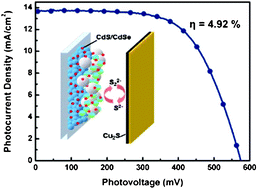Highly efficient CdS/CdSe-sensitized solar cells controlled by the structural properties of compact porous TiO2 photoelectrodes†
Abstract
At present, the photovoltaic performance of

* Corresponding authors
a
Beijing Laboratory for Condensed Matter Physics, Institute of Physics, Chinese Academy of Sciences, Beijing, China
E-mail:
qbmeng@iphy.ac.cn, dmli@iphy.ac.cn
Fax: 86-10-82649242
Tel: 86-10-82649242
b
Department of Engineering Science, Faculty of Informatics and Engineering, The University of Electrocommunicaitons, 1-5-1 Chofugaoka, Chofu, Tokyo 182-8585, Japan
E-mail:
toyoda@pc.uec.ac.jp
Fax: 81-424-43-5501
Tel: 81-424-43-5471
c
PRESTO, Japan Science and Technology Agency, 4-1-8 Honcho Kawaguchi, Saitama 332-0012, Japan
E-mail:
shen@pc.uec.ac.jp
At present, the photovoltaic performance of

 Please wait while we load your content...
Something went wrong. Try again?
Please wait while we load your content...
Something went wrong. Try again?
Q. Zhang, X. Guo, X. Huang, S. Huang, D. Li, Y. Luo, Q. Shen, T. Toyoda and Q. Meng, Phys. Chem. Chem. Phys., 2011, 13, 4659 DOI: 10.1039/C0CP02099K
To request permission to reproduce material from this article, please go to the Copyright Clearance Center request page.
If you are an author contributing to an RSC publication, you do not need to request permission provided correct acknowledgement is given.
If you are the author of this article, you do not need to request permission to reproduce figures and diagrams provided correct acknowledgement is given. If you want to reproduce the whole article in a third-party publication (excluding your thesis/dissertation for which permission is not required) please go to the Copyright Clearance Center request page.
Read more about how to correctly acknowledge RSC content.
 Fetching data from CrossRef.
Fetching data from CrossRef.
This may take some time to load.
Loading related content
